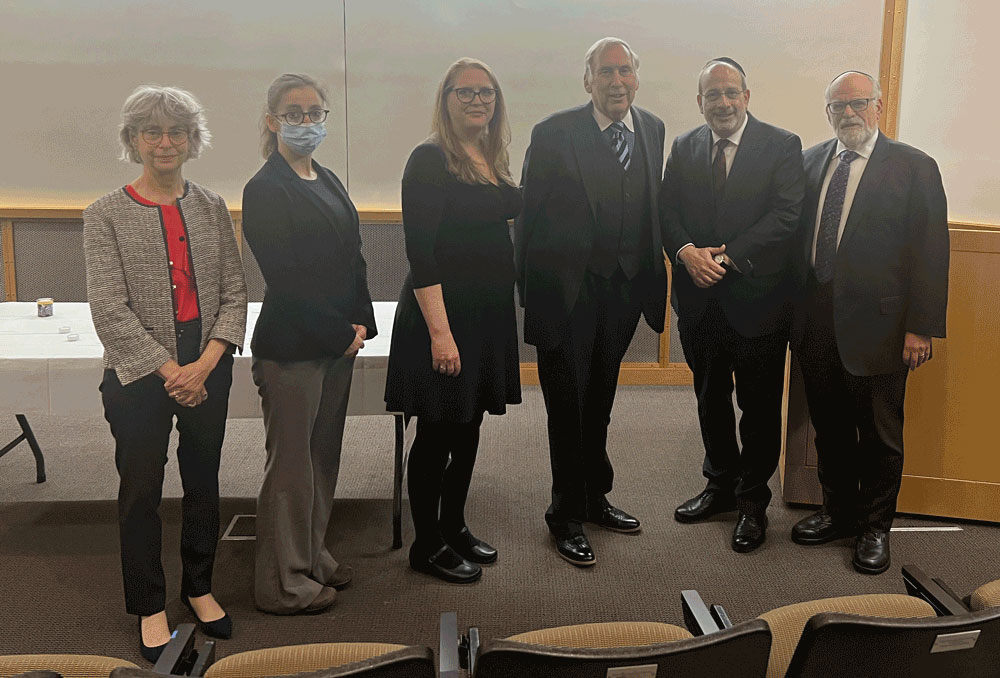Yom Hashoah Observance Explores the “Dachau Ashes”
Dr. Halperin Presented the Complex and Troubling Story of the “Dachau Ashes”

The New York Medical College (NYMC) and Touro University (TU) communities gathered for a melancholy observation of Yom Hashoah on May 4 in Nevins Auditorium. A moving presentation by Edward C. Halperin, M.D., M.A., chancellor, chief executive officer, interim dean of the School of Medicine (SOM), the Miriam Popack Chair of Biomedical Ethics after the Holocaust, director of the Hirth and Samowitz Center for Medical Humanities and Holocaust Studies and provost for biomedical affairs at TU, explored the story of the “Dachau ashes.” View the video.
Marie T. Ascher, M.S., M.P.H., the Lillian Hetrick Huber Endowed director of the Phillip Capozzi, M.D., Library, moderated the program. Anne Bayefsky, M.A., LLB, director of Touro Institute on Human Rights and the Holocaust lit the memorial candle and recited the poems, Who Am I To Speak of a Time? and The Blessing of the Yellow Candle. Attendees lit the candles in memoriam for the lives lost in the Holocaust throughout the event.
Dr. Halperin presented new scientific research that demonstrated that the "Dachau ashes" that were analyzed by NYMC and buried in 2014 were more complex and sinister than previously described. Giving context to the introduction of the term “concentration camp” in the English language, which was during the Anglo-Boer Wars from 1899 to 1902, when the British forced women and children from South Africa in concentration camps, Dr. Halperin then explained the development of German concentration camps and killing factories following German expansion after the rise of Adolf Hitler and the conditions of the Dachau concentration camp.
He told the story of U.S. soldier and North Carolina repairman for addressographs, Walter Corsbie, who was given a lump of a rounded cement-like material assumed to be the ashes from a crematorium and was told to keep the object as a souvenir of the Dachau camp. For 30 years, the cement-like object stayed on his nightstand in a tin cigarette case until it was inherited by his son Joseph Corsbie. He tried to donate the object to the U.S. Holocaust Museum, who said that they are unable to accept human remains, and the Dachau Museum, which claimed the object was crematoria concrete tags. Corsbie contacted a friend and ultimately met with Sharon Halperin, M.P.H., director of the North Carolina Holocaust Speakers Bureau and wife of Dr. Halperin.
Sharon Halperin brought the cement-like object home, where Dr. Halperin started to examine and take pictures of it. John Fallon, M.D., Ph.D., adjunct professor of pathology microbiology and immunology, connected him with The Milton Helpern Institute of Forensic Medicine. The team at the Institute found that there were no bony fragments, however they found that there were human proteins inside the specimen when they used a proteomic mass spectrometry.
Once notified, Corsbie wanted the object to be buried in sanctified grounds. With the approval of the rabbis, arrangements were made for a burial ceremony in 2014 with hundreds in attendance, including Holocaust survivors and Bill Bell, former mayor of Durham. The Holocaust Speakers Bureau placed a descriptive plaque on the fence of the cemetery and the memorial was unveiled a year later. Students from local schools were given tours by the Halperins, who told them about the “Dachau ashes.”
Last summer, Dr. Halperin received an email from Donald Siegal, a biochemist at The Milton Helpern Institute of Forensic Medicine, who revealed that the "Dachau ashes" matched a group of concrete discs in museums in Cape Town, South Africa and Yad Vashem, Israel. The discs had a hole and numbers stamped on them and matched the circumference of the “Dachau ashes.” The people who donated the objects were told that the round cement-like objects were assumed to be covered with fat and used as artificial soap or a tag for the belonging before people entered the gas chambers.
Germany faced a shortage of concrete following the bombing of concrete manufacturing factories. Human bones from the concentration camps were possibly grinded to be used as aggregate, instead of gravel or pebbles, for concrete. There’s a strong possibility that people in the concentration camps used the "Dachau ashes" as coat checks or soap to avoid a stampede from entering the gas chambers disguised as showers.
“What you heard are the end results of eugenics in medicine,” said Dr. Halperin. “The fingerprints of medicine is all over those discs because it was geneticists and doctors interpreting mendelian genetics and Charles Darwin to give us this kind of intellectual justification for this.”
Members of the community were in disbelief of the barbaric discovery. Margot Lurie, SOM 2024, responded to the presentation by addressing how to deal with Holocaust era human remains. “The story of the Holocaust isn’t over and it never will be,” said Lurie. “We will continue to find victims and continue to tell their stories and we will continue to remember. The publication of this paper and the substantiation of protein recovery is an exemplary model of our obligation to use scientific methods to document history.”
Rabbi Moshe D. Krupka, M.S., the executive vice president of TU, shared the heartbreaking experience to of a late Holocaust survivor, Yosef Stern, who lost many family members before coming to the Unites States. He concluded the event with a prayer with Paul Glasser, vice president on Institutional Advancement at TU.
“There can be no greater lesson for us on this health sciences campus,” said Rabbi Krupka. “Take the lessons that we have learned from the slides from Dr. Halperin’s presentation and Margot’s response. Yes, there is evil and racism in this world. There are horrible people who do horrible things, but we will make it better. That is what we stand for and who we are.”
